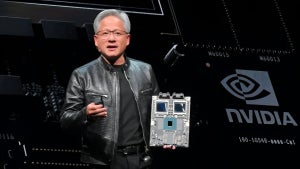ChatGPT drains a half-liter bottle of water with each conversation—is there a solution?
It is known that many artificial intelligence centers use water to function, a resource that is increasingly scarce

- September 5, 2024
- Updated: October 16, 2024 at 8:42 PM

In the last two years, artificial intelligence has become the most popular topic in modern society. This shift has generated a broad awareness of the technology’s environmental implications, mainly focused on the enormous amounts of energy and water required to train and implement these models.

Subscribe to the Softonic newsletter and get the latest in tech, gaming entertainment and deals right in your inbox.
Subscribe (it's FREE) ►As The Register reminds us, a recent report found that water consumption in northern Virginia data centers, the world capital of data centers, has increased by two-thirds in the last five years.
“ChatGPT needs to ‘drink’ a 500 ml bottle of water for a simple conversation of about 20-50 questions and answers, depending on when and where ChatGPT is deployed,” the researchers estimated in an article published early last year.
To make matters worse, it was a GPT-3 model with around 175 billion parameters, which seems insignificant by today’s standards. It is estimated that GPT-4 will have between 1.7 and 1.8 trillion parameters, and as Trevor Cai from OpenAI said, these models will only continue to grow.
Although that doesn’t bode well for data center energy consumption, the same may not be true for their water addiction. At least, it doesn’t have to be.
AI can do without water, but not without electricity
First, data centers do not consume water. The real problem is that water is extracted from the local environment without being returned to its source. Secondly, IT infrastructure, whether related to AI or not, is not the one that actually consumes water.
Even when liquid-cooled, these systems are usually closed circuits that do not lose a significant amount of fluids during their normal operation.
Barn coolers, often called evaporative coolers or swamp coolers, consume all that water. They prevent these systems from overheating.
However, it is essential to note that this is a design decision and that evaporative coolers are not used in all facilities. If Meta or Amazon install an artificial intelligence data center in your backyard, they will put pressure on the local power grid, but that does not necessarily mean they will consume a quarter of your city’s water supply.
In colder climates, dry coolers and the so-called “free cooling” are suitable, while in warmer and drought-prone regions, it is not uncommon for distribution center operators to opt for refrigerant-based systems. The latest news is that this is precisely what Microsoft does with its distribution center in Goodyear (Arizona), although only after a dispute with the city over wastewater.
Why is water still being used? Because it is cheaper
Although there is not much to do in the existing facilities, the decision to use evaporative cooling in new constructions ultimately comes down to greed or, to use politically correct language, capitalism.
For hyper-scalers, in particular, it all comes down to margins. If you can do something 5% cheaper or more efficient than the competition, you can gain much more profit or reduce costs and win their customer base.
It turns out that water is incredibly efficient at extracting heat from the air compared to other alternative technologies. This translates into lower electricity costs or the possibility of building larger and denser facilities in energy-scarce locations.
Even with industrial rates, electricity costs are increasing rapidly. Therefore, the technology offers a competitive advantage in markets where evaporative coolers are viable.
Ultimately, it all comes down to this: either more energy is used, or more water is consumed. If water is cheaper than electricity and is perceived as abundant, as with the Great Lakes, one can guess which operators will choose.
Journalist specialized in technology, entertainment and video games. Writing about what I'm passionate about (gadgets, games and movies) allows me to stay sane and wake up with a smile on my face when the alarm clock goes off. PS: this is not true 100% of the time.
Latest from Chema Carvajal Sarabia
- Google is no longer what it used to be: working for them is no longer the dream of every engineer
- AMD changes its gaming approach thanks to the success of the RX 9000 series
- Descubren que el uso de “por favor” y “gracias” con la IA conduce a mejores respuestas
- The Outlast Trials will launch user-generated content on April 22
You may also like

Ghost of Yotei is already the most pre-ordered game in 20 countries around the world
Read more

With the delay of GTA6, Kingdom Come: Deliverance 2 sees the path open to being the game of the year
Read more

Do you know Manus AI? This is the AI that competes with the Chinese DeepSeek
Read more

Nintendo sues an accessory company for leaking the design of the Switch 2
Read more

Nvidia wants to start selling in China again to boost its stock prices: they have a plan
Read more

This new mod turns Oblivion Remastered into Dark Souls
Read more